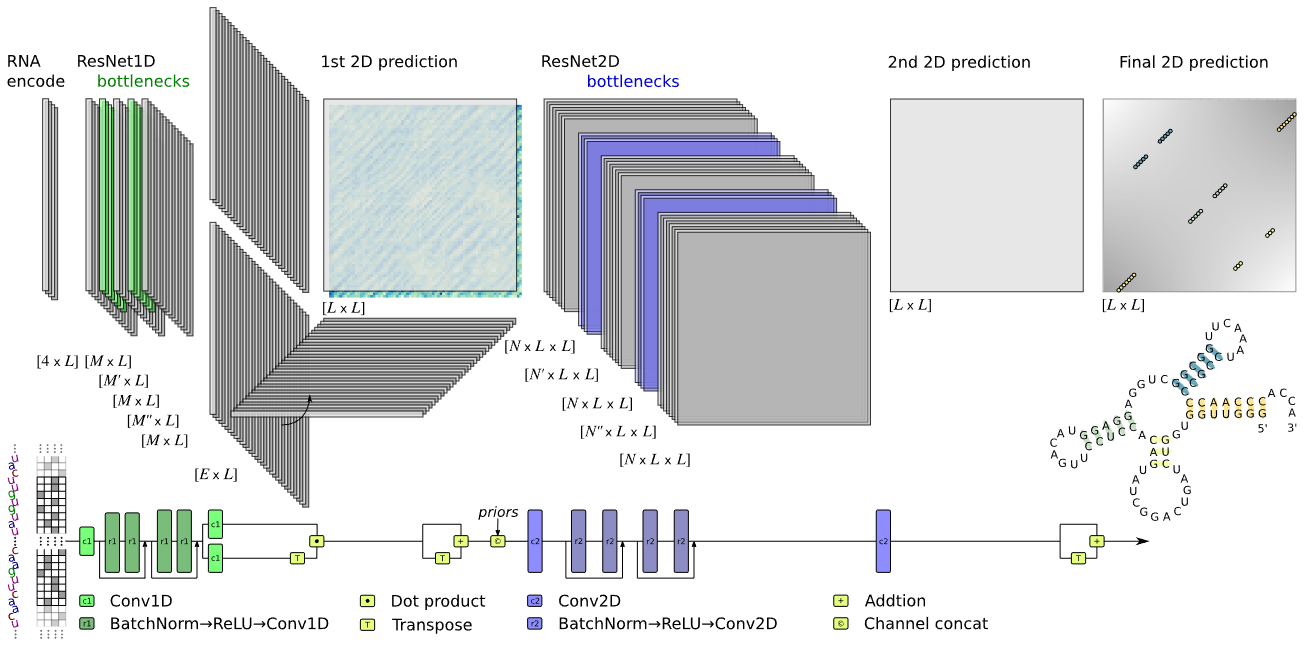An end-to-end method to predict RNA secondary structure based on deep learning
Project description
sincFold
This is the repository for sincFold, a new RNA secondary folding prediction tool based on deep learning.

SincFold is a fast and accurate RNA secondary structure prediction method. It is an end-to-end approach that predicts the contact matrix using only the sequence of nucleotides as input. The model is based on a residual neural network that can learn short and long context interactions. Extensive experiments on several benchmark datasets were made, comparing sincFold against classical methods and new models based on deep learning. We demonstrate that sincFold achieves the best performance in comparison with state-of-the-art methods.
A summary of results can be seen in this notebook.
Folding RNA sequences
We have a web demo (mirror) running with the latest version. This server admits one sequence at a time. We provide a model pre-trained with validated RNA datasets. Please follow the next instructions if you want to run the model locally.
Install
This is a Python package. It is recommended to use virtualenv or conda to create a new environment. To install the package, run:
pip install sincfold
Alternativelly, you can clone the repository with:
git clone https://github.com/sinc-lab/sincFold
cd sincFold/
and install with:
pip install .
on Windows, you will probably need to add the python scripts folder to the PATH.
Predicting sequences
To predict the secondary structure of a sequence using the pretrained weights:
sincFold pred AACCGGGUCAGGUCCGGAAGGAAGCAGCCCUAA
This will display the predicted dot-bracket in the console.
SincFold also supports files with multiple sequences in .csv and .fasta format as inputs, and providing .csv or .ct format outputs.
echo -e ">seq1\\nAACCGGGUCAGGUCCGGAAGGAAGCAGCCCUAA" > sample.fasta
echo -e ">seq2\\nGUAGUCGUGGCCGAGUGGUUAAGGCGAUGGACUAGAAAUCCAUUGGGGUCUCCCCGCGCAGGUUCGAAUCCUGCCGACUACGCCA" >> sample.fasta
sincFold pred sample.fasta -o pred_ct_files/
We also provide this notebook to run the sincFold functions.
Training and testing models
A new model can be trained using the train option. For example, download this training set:
wget "https://raw.githubusercontent.com/sinc-lab/sincFold/main/sample/train.csv"
and then run sincFold with:
sincFold -d cuda train train.csv -n 10 -o output_path
The option "-d cuda" requires a GPU (otherwise remove it), and -n limits the maximum number of epochs to get a quick result. The output log and trained model will be saved in the directory output_path.
Then, a different test set can be evaluated with the test option. You can download this sample file form:
wget "https://raw.githubusercontent.com/sinc-lab/sincFold/main/sample/test.csv"
and test the model with:
sincFold test test.csv -w output_path/weights.pmt
The model path (-w) is optional, if omitted the pretrained weights are used.
Reproducible research
You can run prepare train and test partitions using the following code (in this case set up ArchiveII and fold 0 data partition). The "data/" folder can be found in this repository.
import os
import pandas as pd
out_path = f"working_path/"
os.mkdir(out_path)
# read dataset and predefined partitions (the files are available in this repository)
dataset = pd.read_csv("data/ArchiveII.csv", index_col="id")
partitions = pd.read_csv("data/ArchiveII_splits.csv")
dataset.loc[partitions[(partitions.fold_number==0) & (partitions.partition=="train")].id].to_csv(out_path + "train.csv")
dataset.loc[partitions[(partitions.fold_number==0) & (partitions.partition=="valid")].id].to_csv(out_path + "valid.csv")
dataset.loc[partitions[(partitions.fold_number==0) & (partitions.partition=="test")].id].to_csv(out_path + "test.csv")
then call the training and testing functions
sincFold -d cuda train working_path/train.csv --valid-file working_path/valid.csv -o working_path/output/
sincFold -d cuda test working_path/test.csv -w working_path/output/weights.pmt
Using a GPU for training is recommended (with the option '-d cuda'). The complete process may take several hours using a GPU.
@article{sincFold2023,
title={sincFold: end-to-end learning of short- and long-range interactions for RNA folding},
author={Leandro A. Bugnon and Leandro Di Persia and Matias Gerard and Jonathan Raad and
Santiago Prochetto and Emilio Fenoy and Uciel Chorostecki and Federico Ariel and
Georgina Stegmayer and Diego H. Milone},
journal={under review, bioRxiv},
url={https://www.biorxiv.org/content/10.1101/2023.10.10.561771v2}
year={2023}
}
Project details
Release history Release notifications | RSS feed
Download files
Download the file for your platform. If you're not sure which to choose, learn more about installing packages.
Source Distribution
Built Distribution
Hashes for sincfold-0.16.2-py3-none-any.whl
| Algorithm | Hash digest | |
|---|---|---|
| SHA256 | 41a67b422aed1b1ac0a1c65fe86dfd9fe8300f686b237a8f36075db0af7314a4 |
|
| MD5 | e972bc73360a3c3f3035d09ecb188a6c |
|
| BLAKE2b-256 | 720f52e9d6af9b57c77092ffbc0ca8c68bb998aeb7728f7f1f43cf6c5a43c040 |











